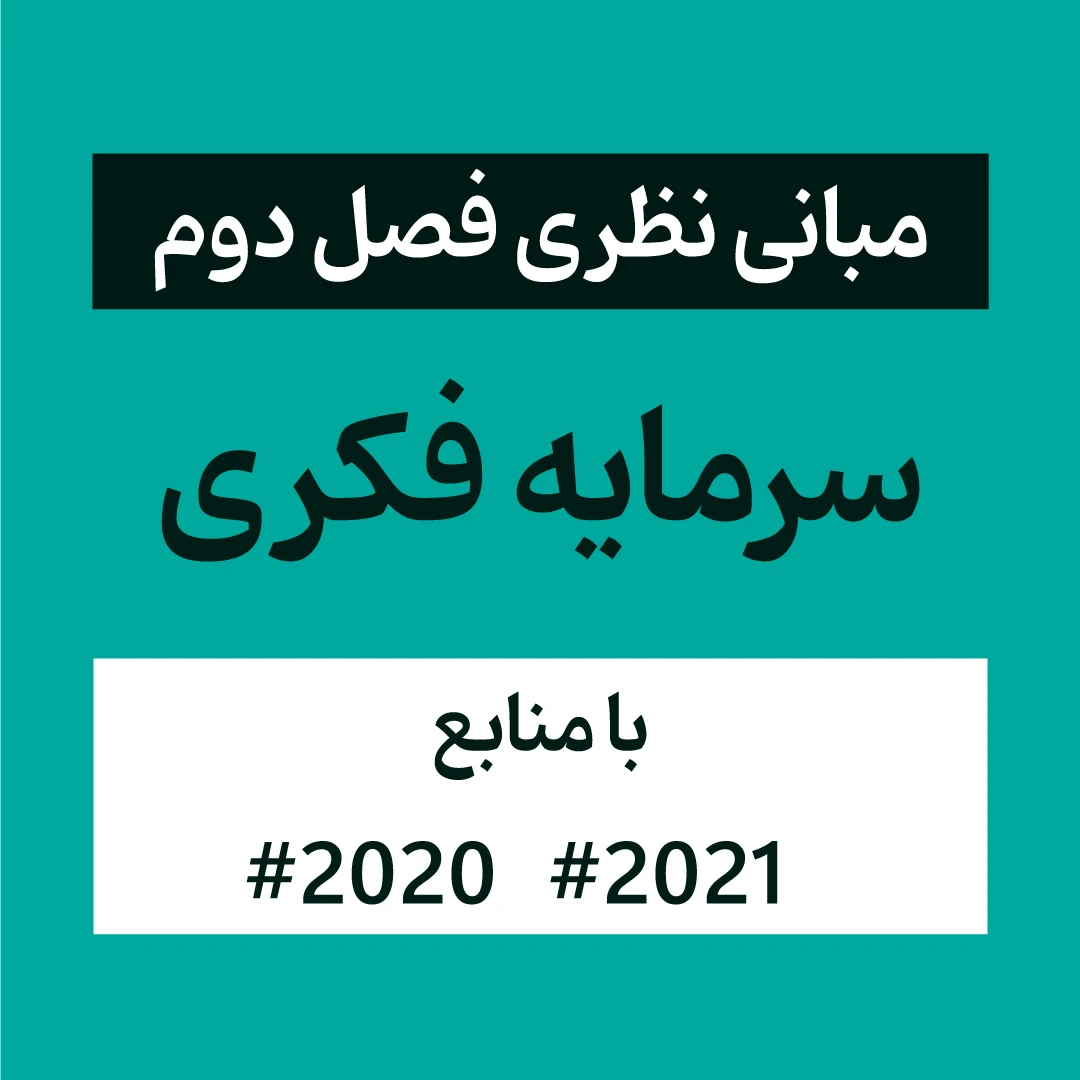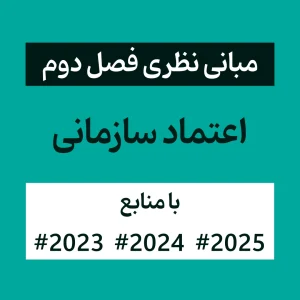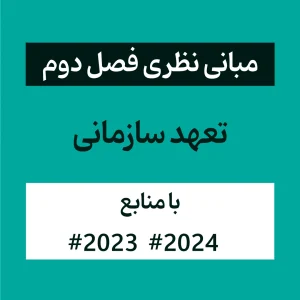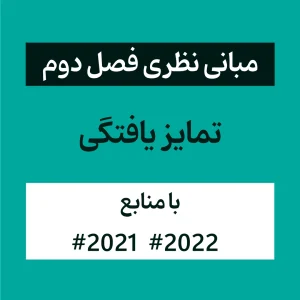نقد و بررسی
مبانی نظری و پیشینه پژوهش سرمایه فکری با منابع 2020-2021فهرست مطالب:
- سرمایه فکری
- تعاریف برای سرمایه فکری
- نظریه های سرمایه فکری
- منابع فارسی
- منابع غیر فارسی
بخشی از محصول
سرمایه فکری موضوع جدیدی است که در چندسال اخیر در سطح بین المللی مطرح و مورد مطالعه پژوهشگران مختلف حیطه منابع انسانی و رفتار سازمانی قرار گرفته است. و به دلیل اینکه یک منبع غنی برای سازمان¬ها و کسب و کارهای مختلف محسوب می¬شود به سرعت در حال تبدیل شدن به یکی از مهمترین معیارهای توسعه یافتگی است (عزیزی و همکاران، 1403).
منابع فارسی
- عزیزی، سید فاضل، محرمی، حسین (1403). بررسی ارتباط سرمایه فکری با توسعه حرفهای معلمان. محل انتشار: اولین کنفرانس بینالمللی روانشناسی، علوم تربیتی، مدیریت و علوم اجتماعی.
- احمدی شریف، محمود، موسوی ورزقانی، مهدی، رحمتپور، زهرا (1403). تاثیر فرآیند مدیریت دانش و سرمایه فکری بر جهتگیری کارآفرینی و نوآوری. محل انتشار: یازدهمین کنفرانس بینالمللی چشماندازهای نوین در مدیریت، حسابداری و کارآفرینی. صفحات: 1 تا 9.
- گلستانی، مریم، علیخانی، محسن، سقایی، غلامرضا (1403). تاثیر کارایی سرمایه انسانی و فکری بر عملکرد شرکتها با توجه به نقش عمر شرکت و بدهیها. محل انتشار: یازدهمین کنفرانس بینالمللی چشماندازهای نوین در مدیریت، حسابداری و کارآفرینی. صفحات: 1 تا 26.
- سواری، فاطمه (1403). بررسی تاثیر مدیریت دانش و سرمایه فکری بر بهبود تصمیمگیری مدیران و ارزشآفرینی سازمان. نویسندگان: فاطمه سواری. محل انتشار: سومین کنگره بینالمللی مدیریت، اقتصاد، علوم انسانی و توسعه کسبوکار.
Non-Persian References
- Brooking, Annie (1996). Intellectual Capital: Core Asset for the Third Millennium Enterprise, International Thomson Business Press, New York.
- Edvinsson, Leif and Michael S. Malone (1997). Intellectual Capital: Realizing Your Company’s True Value by Finding Its Hidden Roots, HarperCollins Publishers, Inc., New York.
- Kaplan, Robert S. and David P. Norton (1996). The Balanced Scorecard, Harvard Business School Press, Boston.
- Stewart, Thomas A. (1995). “Trying to Grasp the Intangible,” Fortune, October 2, 1995, pp. 157-61.
- Skandia (1994). Visualizing Intellectual Capital in Skandia, Supplement to Skandia’s 1994 Annual Report.
- Ali, Mostafa A., Nazimah Hussin, Hader Khadum Jabbar, Ibtihal A. Abed, Rafidah Othman, and Mohammed A. Mohammed. (2020a). Intellectual Capital and Firm Performance Classification and Motivation: Systematic Literature Review. TEST Engineering & Management 3: 28691–703.
- Ali, Mostafa A., Nazimah Hussin, Hossam Haddad, Dina Alkhodary, and Ahmad Marei. (2021a). Dynamic Capabilities and Their Impact on Intellectual Capital and Innovation Performance. Sustainability 13: 10028.
- Alrowwad, Ala. (2020). Innovation and Intellectual Capital as Intermediary Variables among Transformational Leadership, Transactional Leadership, and Organizational Performance. Journal of Management Development 39: 196–222.
- Batjargal, Bat. (2007). Internet Entrepreneurship: Social Capital, Human Capital, and Performance of Internet Ventures in China. Research Policy 36: 605–18.
- Bolino, Mark C., William H. Turnley, and James M. Bloodgood. (2002). Citizenship Behavior and the Creation of Social Capital in Organizations. Academy of Management Review 27: 505–22.
- Bontis, Nick. (2001). Assessing Knowledge Assets: A Review of the Models Used to Measure Intellectual Capital. International Journal of Management Reviews 3: 41–60.
- Cabrilo, Slaðana, and Sven Dahms. (2020). The Role of Multidimensional Intellectual Capital and Organizational Learning Practices in Innovation Performance. European Management Review 17: 835–55.
- Enkel, Ellen, and Veronika Sagmeister. (2020). External Corporate Venturing Modes as New Way to Develop Dynamic Capabilities. Technovation 2018: 102128.
- Ferreira, Jorge, Arnaldo Coelho, and Luiz Moutinho. (2020). Dynamic Capabilities, Creativity and Innovation Capability and Their Impact on Competitive Advantage and Firm Performance: The Moderating Role of Entrepreneurial Orientation. Technovation 92: 102061.
- Fincham, Robin, and Robin Roslender. (2003). Intellectual Capital Accounting as Management Fashion: A Review and Critique. European Accounting Review 12: 781–95.
- Furnival, Joy, Ruth Boaden, and Kieran Walshe. (2019). A Dynamic Capabilities View of Improvement Capability. Journal of Health Organization and Management 33: 821–34.
- García Lirios, Cruz. (2020). Specification a Model for Study of Intellectual Capital. Behavior Studies in Organizations 3: 1–4.
- Garrido, Ivan Lapuente, Caroline Kretschmer, and Silvio Luis De Vasconcellos. (2020). Dynamic Capabilities: A Measurement Proposal and Its Relationship with Performance. Brazilian Business Review 17: 46–65.
- Helfat, Constance E., S. Finkelstein, W. Mitchell, M. A. Peteraf, H. Singh, D. J. Teece, and S. G. Winter. (2007). Dynamic Capabilities: Foundations. In Dynamic Capabilities: Understanding Strategic Change in Organizations. Houston: Wiley, pp. 30–45.
- Lamond, David, Yi-Chun Huang, and Yen-Chun Jim Wu. (2010). Intellectual Capital and Knowledge Productivity: The Taiwan Biotech Industry. Management Decision 48: 580–99.
- Li, Yongfu, Yu Song, Jinxin Wang, and Chengwei Li. (2019). Intellectual Capital, Knowledge Sharing, and Innovation Performance: Evidence from the Chinese Construction Industry. Sustainability 11: 2713.
- Nahapiet, Janine, and Sumantra Ghoshal. (1998). Social Capital, Intellectual Capital, and the Organizational Advantage. Academy of Management Review 23: 242–66.
- Salicru, Sebastian, and Chris Perryer. (2007). Intellectual Capital and Company Performance—Literature Review and Research Opportunities in Australia. Paper presented at the 21st Annual Australian and New Zealand Academy of Management Conference, Sydney, Australia, January 1–19.
- Stewart, Thomas A. (1997). Intellectual Capital: The New Wealth of Organizations. New York: Bantam Doubleday Dell Publishing Group, Inc.
- Tayles, Mike, Richard H. Pike, and Saudah Sofian. (2007). Intellectual Capital, Management Accounting Practices and Corporate Performance. Accounting, Auditing & Accountability Journal 20: 522–48.
- Xu, Jian, and Binghan Wang. (2018). Intellectual Capital, Financial Performance and Companies’ Sustainable Growth: Evidence from the Korean Manufacturing Industry. Sustainability 10: 4651.








0دیدگاه